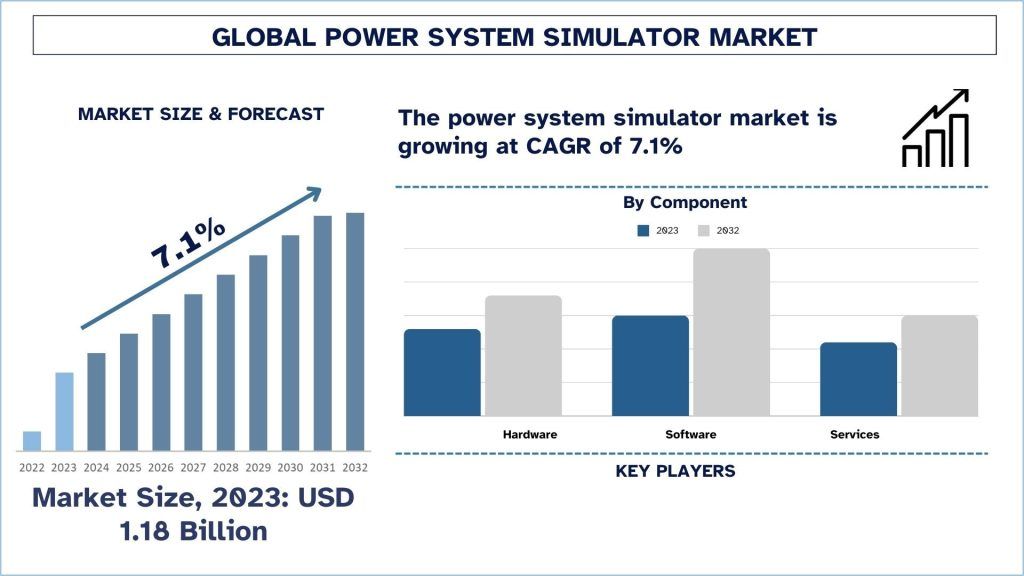- Home
- About Us
- Industry
- Services
- Reading
- Contact Us
Power System Simulator Market: Current Analysis and Forecast (2024-2032)
Emphasis on Module (Load Flow, Harmonics, Short Circuit, Device Coordination Selectivity, Arc Flash, and Others); Component (Hardware, Software, and Services); End-Users (Power, Industry, and Others); and Region/Country
Power System Simulator Market Size & Forecast
The Power System Simulator market was valued at approximately USD 1.18 Billion in 2023 and is expected to grow at a robust CAGR of around 7.1 % during the forecast period (2024-2032) owing to the increasing global demand for electricity.
Power System Simulator Market Analysis
Power system simulation is a mature application for modeling, analyzing, and optimizing the performance of electrical power systems. Such simulators are critical to guaranteeing power grids’ performance, reliability, and robustness as they continuously add more renewable energy resources and transform them to become much brighter. They allow utilities and grid operators to model different scenarios, predict potential problems that may arise in specific conditions, and help build efficient grid management and optimization methods. An example of this is in 2023 when the New York Independent System Operator (NYISO) used power system simulators to integrate significant growth in renewable energy capacity while maintaining grid stability and reliability. This instance further illustrates the importance of power system simulators and their role in enabling a smoother shift toward sustainable, stable energy infrastructure.
As newly shaped power systems are becoming more complex and dynamic, it is noteworthy that the use of power system simulators is expanding rapidly. More utility systems are turning to variable renewable energy sources such as wind and solar power and hence need simulators to manage the grid’s stability. As new and efficient technologies continue to develop the grid, complex and diverse communication and control functions propel the development of effective simulation models. For example, in August 2020, the F6150sv, which is a power system simulator, succeeded in performing the basic tests to the most complex ones. The one has the highest output current of any test set on the market- all integrated within one unit. It applies IEC 61850 – based systems at the process-bus and station-bus levels with sampled values and GOOSE messages. Fears of cyber-attacks and the modernization of the grid in regions with old infrastructure have also led to higher spending on the tools. This, coupled with other government policies and regulations that aim at increasing the use of renewable energy and the grid’s reliability, also supplements the use of power system simulators, which are crucial in planning future energy needs.
Power System Simulator Market Trends
This section discusses the key market trends influencing the power system simulator market segments as identified by our research experts.
Load Flow Module Transforming Industry
The load flow segment dominated the market in 2023. One of the primary drivers is the increasing demand for reliable and efficient power supply due to rising electricity consumption globally. This surge in demand necessitates advanced tools for planning and managing power distribution, leading to a higher adoption of load flow systems. Additionally, integrating renewable energy sources into the power grid creates complexities in power flow management, further boosting the need for sophisticated simulation tools. Technological advancements in simulation software, providing more accurate and real-time analysis, also play a significant role in market growth. Furthermore, the growing emphasis on smart grid technologies and the digitalization of power utilities encourage the adoption of advanced load flow systems.
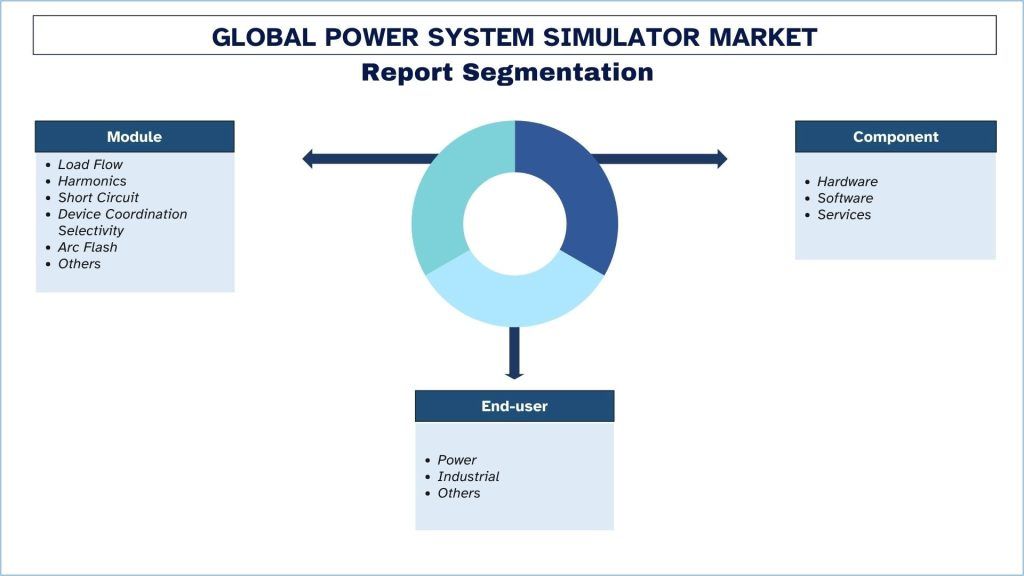
North America is Expected to Grow with Significant CAGR During Forecast Period
North America holds a significant share of the wind turbine foundation market and is anticipated to maintain a steady growth rate over the forecast period. The power system simulator market in North America is experiencing significant growth due to technological, regulatory, and market-driven factors. The increasing integration of renewable energy sources, such as wind and solar, into the power grid is a primary driver, necessitating advanced simulation tools to manage variability and ensure grid stability. Regulatory mandates aimed at reducing carbon emissions and promoting sustainable energy practices further propel the adoption of power system simulators. Additionally, the region’s focus on modernizing aging power infrastructure and enhancing grid resilience against extreme weather events and cyber threats has increased investment in simulation technologies. Technological advancements, including real-time data analytics, AI, and machine learning, enhance the capabilities of power system simulators, making them indispensable for efficient grid management. An instance highlighting this growth occurred in 2020 when the U.S. Department of Energy announced a significant investment in advanced grid modeling and simulation tools as part of its Grid Modernization Initiative. This investment aimed to support developing and deploying innovative technologies to improve the nation’s power grid’s reliability, resilience, and security. Such initiatives underscore the critical role of power system simulators in achieving energy goals and addressing emerging challenges in the power sector, thereby driving the market’s growth in North America.
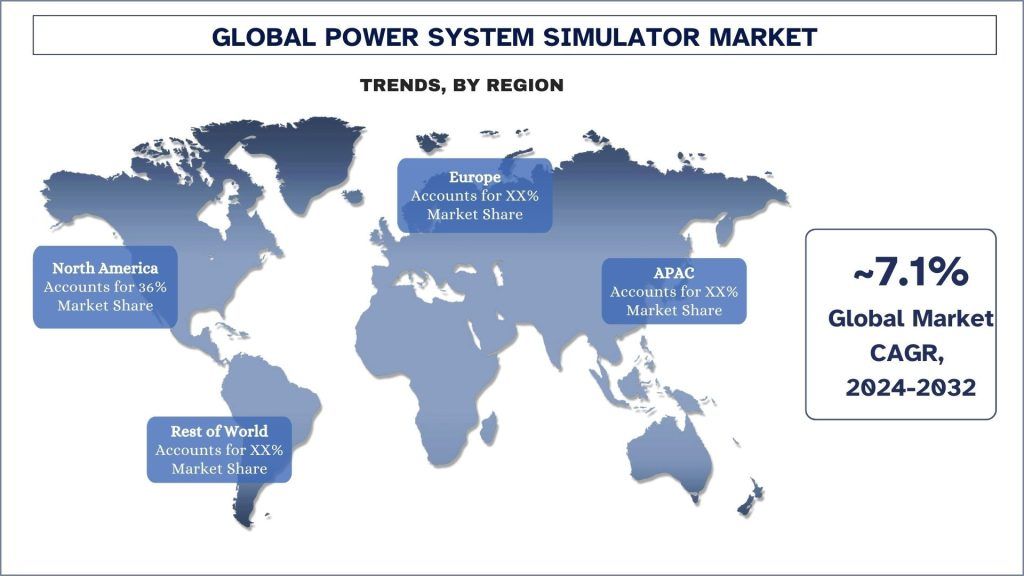
Power System Simulator Industry Overview
The power system simulator market is competitive, with several global and international market players. The key players are adopting different growth strategies to enhance their market presence, such as partnerships, agreements, collaborations, new product launches, geographical expansions, and mergers and acquisitions. Some of the major players operating in the market are ABB, Schneider Electric, Eaton, Siemens, General Electric Company, Operation Technology, Inc., Aspen Technology Inc, The MathWorks, Inc, OPAL-RT TECHNOLOGIES, PowerWorld Corporation.
Power System Simulator Market News
- In June 2021 – Fuji Electric Co., Ltd. announced the launch of the 7500WX Series, a high-capacity, uninterruptible power supply system.
- In December 2022, Schneider Electric plans to double its manufacturing capabilities by developing a new smart factory in Bengaluru.
Power System Simulator Market Report Coverage
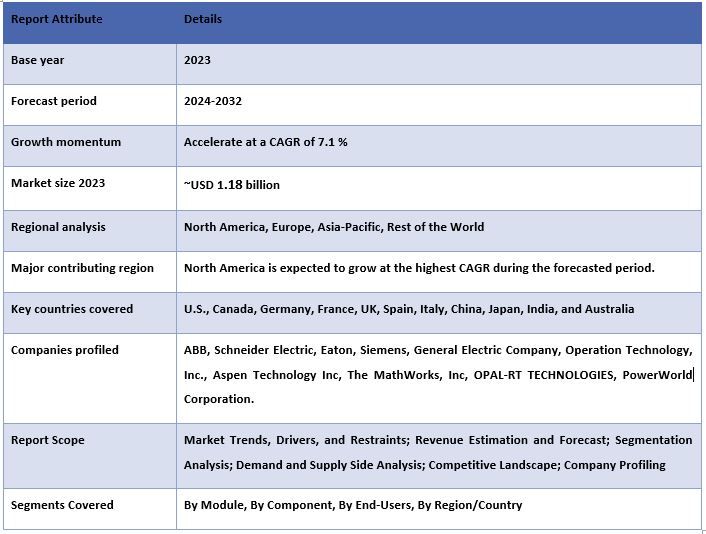
Reasons to buy this report:
- The study includes market sizing and forecasting analysis validated by authenticated key industry experts.
- The report presents a quick review of overall industry performance at one glance.
- The report covers an in-depth analysis of prominent industry peers with a primary focus on key business financials, product portfolios, expansion strategies, and recent developments.
- Detailed examination of drivers, restraints, key trends, and opportunities prevailing in the industry.
- The study comprehensively covers the market across different segments.
- Deep dive regional level analysis of the industry.
Customization Options:
The global power system simulator market can further be customized as per the requirement or any other market segment. Besides this, UMI understands that you may have your own business needs; hence, feel free to connect with us to get a report that completely suits your requirements.
Table of Content
Research Methodology for the Power System Simulator Market Analysis (2022-2032)
Analyzing the historical market, estimating the current market, and forecasting the future market of the global Power System Simulator market were the three major steps undertaken to create and analyze the adoption of Power System Simulator in major regions globally. Exhaustive secondary research was conducted to collect the historical market numbers and estimate the current market size. Secondly, numerous findings and assumptions were taken into consideration to validate these insights. Moreover, exhaustive primary interviews were also conducted, with industry experts across the value chain of the global Power System Simulator market. Post assumption and validation of market numbers through primary interviews, we employed a top-down/bottom-up approach to forecasting the complete market size. Thereafter, market breakdown and data triangulation methods were adopted to estimate and analyze the market size of segments and sub-segments of the industry. Detailed methodology is explained below:
Analysis of Historical Market Size
Step 1: In-Depth Study of Secondary Sources:
Detail secondary study was conducted to obtain the historical market size of the Power System Simulator market through company internal sources such as annual reports & financial statements, performance presentations, press releases, etc., and external sources including journals, news & articles, government publications, competitor publications, sector reports, third-party database, and other credible publications.
Step 2: Market Segmentation:
After obtaining the historical market size of the power system simulator market, we conducted a detailed secondary analysis to gather historical market insights and share for different segments & sub-segments for major regions. Major segments are included in the report, such as modules, components, end-users, and regions. Further country-level analyses were conducted to evaluate the overall adoption of testing models in that region.
Step 3: Factor Analysis:
After acquiring the historical market size of different segments and sub-segments, we conducted a detailed factor analysis to estimate the current market size of the Power System Simulator market. Further, we conducted factor analysis using dependent and independent variables such as module, component, end-users, and power system simulator market regions. A thorough analysis of demand and supply-side scenarios was conducted, considering top partnerships, mergers and acquisitions, business expansion, and product launches in the power system simulator market sector across the globe.
Current Market Size Estimate & Forecast
Current Market Sizing: Based on actionable insights from the above three steps, we arrived at the current market size, key players in the global Power System Simulator market, and market shares of the segments. All the required percentage shares split, and market breakdowns were determined using the above-mentioned secondary approach and were verified through primary interviews.
Estimation & Forecasting: For market estimation and forecast, weights were assigned to different factors including drivers & trends, restraints, and opportunities available for the stakeholders. After analyzing these factors, relevant forecasting techniques i.e., the top-down/bottom-up approach were applied to arrive at the market forecast for 2032 for different segments and sub-segments across the major markets globally. The research methodology adopted to estimate the market size encompasses:
- The industry’s market size, in terms of revenue (USD) and the adoption rate of the power system simulator market across the major markets domestically
- All percentage shares, splits, and breakdowns of market segments and sub-segments
- Key players in the global power system simulator market in terms of products offered. Also, the growth strategies adopted by these players to compete in the fast-growing market.
Market Size and Share Validation
Primary Research: In-depth interviews were conducted with the Key Opinion Leaders (KOLs), including Top Level Executives (CXO/VPs, Sales Head, Marketing Head, Operational Head, Regional Head, Country Head, etc.) across major regions. Primary research findings were then summarized, and statistical analysis was performed to prove the stated hypothesis. Inputs from primary research were consolidated with secondary findings, hence turning information into actionable insights.
Split of Primary Participants in Different Regions
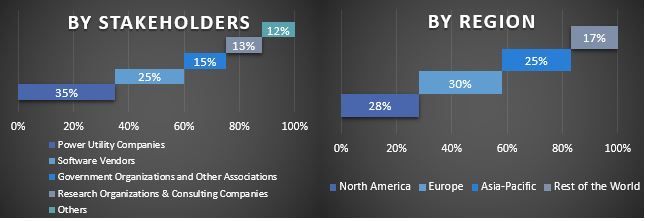
Market Engineering
The data triangulation technique was employed to complete the overall market estimation and to arrive at precise statistical numbers for each segment and sub-segment of the global power system simulator market. Data was split into several segments and sub-segments after studying various parameters and trends in the module, component, end-users, and regions of the global Power System Simulator market.
The main objective of the Global Power System Simulator Market Study
The current & future market trends of the global power system simulator market were pinpointed in the study. Investors can gain strategic insights to base their discretion for investments on the qualitative and quantitative analysis performed in the study. Current and future market trends determined the overall attractiveness of the market at a regional level, providing a platform for the industrial participant to exploit the untapped market to benefit from a first-mover advantage. Other quantitative goals of the studies include:
- Analyze the current and forecast market size of the Power System Simulator market in terms of value (USD). Also, analyze the current and forecast market size of different segments and sub-segments.
- Segments in the study include areas of modules, components, end-users, and regions.
- Define and analyze the regulatory framework for the Power System Simulator
- Analyze the value chain involved with the presence of various intermediaries, along with analyzing customer and competitor behaviors of the industry.
- Analyze the current and forecast market size of the Power System Simulator market for the major region.
- Major countries of regions studied in the report include Asia Pacific, Europe, North America, and the Rest of the World
- Company profiles of the Power System Simulator market and the growth strategies adopted by the market players to sustain in the fast-growing market.
- Deep dive regional level analysis of the industry
Frequently Asked Questions FAQs
Q1: What is the global power system simulator market's current size and growth potential?
Q2: What are the driving factors for the growth of the global power system simulator market?
Q3: Which segment has the largest share of the global power system simulator market by module?
Q4: What are the emerging technologies and trends in the global power system simulator market?
Q5: Which region will dominate the global power system simulator market?
Related Reports
Customers who bought this item also bought

